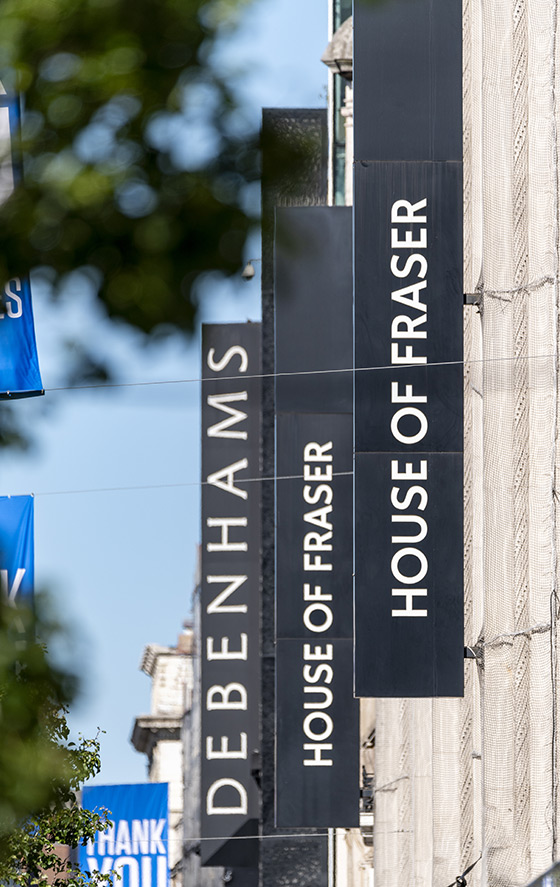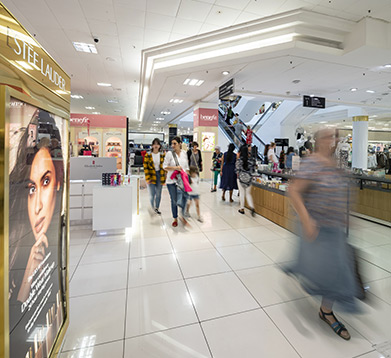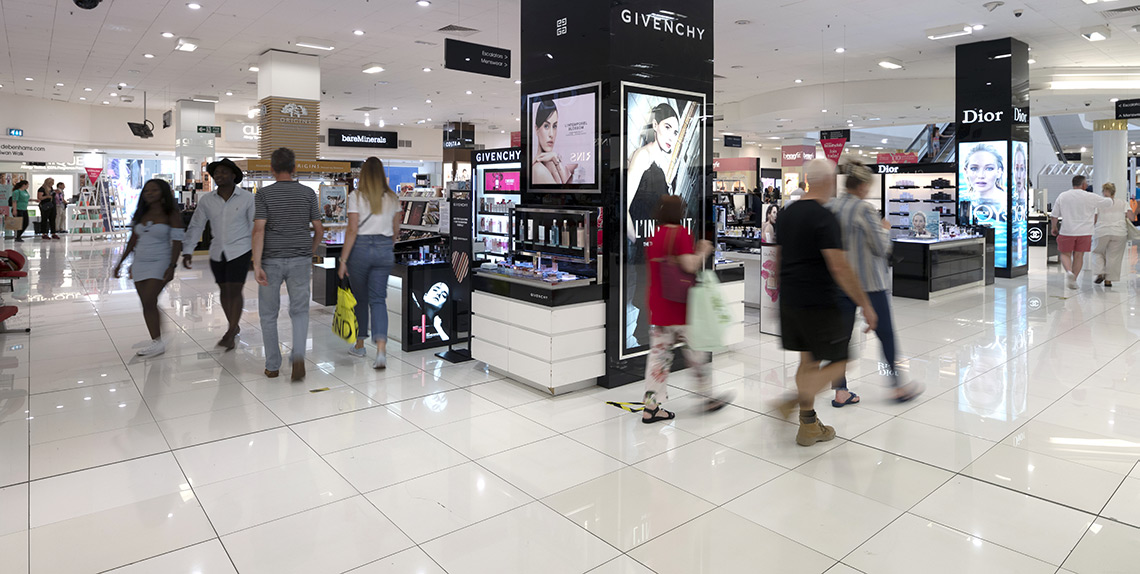What role do our largest stores have in repositioning or repurposing the high street?
A state of flux
The collapse of BHS gave the market a stark warning of what could happen to the brand that time forgot. Four years later a quarter of their stores remain vacant and with a tranche of department stores likely to follow, is repurposing the answer?
In 2017, Department stores in the UK turned over £10.6bn. In 2019 this fell to £9bn; a reduction of 15% in just two years (Mintel). 5million sqft have already been lost from this retail sub-sector in the last 5 years. The changing fortunes of department stores is well documented and even John Lewis, once the darling of any new retail scheme, has failed to justify the reopening of all of its stores following the Covid pandemic and has permanently shut the doors on several stores opened less than five years.
House of Fraser nearly collapsed in August 2018, before being bought by Sports Direct owner Mike Ashley. Year-on-year pre-tax profits at John Lewis dropped by 99% in the first half of 2018, while Debenhams’ share price plunged from 96p to 3p between 2015 and early 2019, before it entered pre-pack administration in April 2019 and, following several failed attempts to rescue the brand, finally liquidated in December 2020.
So what’s going on? Covid may have been the nail in the coffin, but it was by no means the cause of this decline. Ecommerce, branding, lack of investment all play a role. However, neither does it spell the death of the concept as acquisitive retail brands have been circling for months to get hold of strategically useful stores, while disposing of the rest. It would take a brave person to suggest that department stores no longer have any role to play in our retail places, but a braver one to imply that they can carry on as before.
Department store repurposing
Multiple stores have already either closed, or are in the process of being considered for alternative uses via repurposing, repositioning, rightsizing, or redevelopment.
In the UK, Savills are involved with 41 Debenhams and 10 House of Fraser repurposing projects and are advising other large format retailers on their store rationalising or rightsizing strategies. A similar approach is being seen with our colleagues across Europe and in the US the journey is well underway.
The process can be slow, but the proposition is an exciting one. What better way to breathe life back into town centres by improving and enlivening spaces right at the heart of the consumer offer. If we are to genuinely improve towns, cities and shopping centres, we need large spaces that can be reimagined as something more useful or that is lacking from that place.
These range from schemes that retain the retail frontage on the ground floor either for the same brand to continue to trade, or reconfigured/split units for other retail or leisure occupiers to trade from. There’s a lot of activity across the country, with a myriad of alternative uses in the pipeline (see box).
CASE studies
- Kingston upon Thames: Frasers Group, owner of Sports Direct, Evans Cycles, Flannels, Game, USC and Jack Wills, has planning granted in December 2020 to repurpose an existing high street store opening a 40,000 sqft multiformat, multifloor open plan store with 33 residential apartments above.
- Wandsworth: Gravity is taking the Debenhams department store to create a new 80,000 sqft multi-format leisure concept.
- Liverpool: Next is being downsized to include a self-storage facility.
- Leeds: Debenhams is being considered by a local further education provider, student residential and a boutique hotel.
- Stockport: where there is an oversupply of retail but an undersupply of offices, the M&S is being converted to an 80,000 sqft co-working space called Stok.
- London’s West End: There are proposals on several major department stores with John Lewis announcing half of its 680,000 sqft store will be repurposed to offices.
- Westfield White City: 70,000 sqft former House of Fraser is being converted to co-working space.
- Manchester: Planning is sought to increase the Debenhams to create a 470,000 sqft office scheme.
- Telford: InflataNation has taken the old BHS.
- Birmingham: L&G plans to redevelop the House of Fraser into a 1m sqft office and hotel scheme.
- Edinburgh: The Fraser’s building is being repurposed by Diageo as the Johnny Walker Whisky museum.
- Sheffield: The former Co-op department store has been repurposed as co-working space and food hall Kommune.
- Anthem: A public members club, is looking to acquire department store space that will provide facilities for workspace, meeting rooms, foodhalls, bars and cafés, competitive socialising and fitness and wellbeing.
- Leicester: 300 build-to-rent apartments have been proposed for the Debenhams in High Cross shopping Centre.

Redevelopment viability
Viability can be a challenge, particularly retrofitting different space requirements into what are often historic buildings with projects, taking time as well as money.
Financially, repurposing empty department store space requires significant capital expenditure, but it can it can be worth it to a landlord whose asset values may be suffering from the uncertainty of future income from the present occupier. Department stores typically have huge rental liabilities given unit sizes, but on a square footage basis (often <£10psf), particularly on upper floors, the income from alternative uses can be a compelling proposition. Who should pay for the redevelopment? If the retailer is wanting to downsize then arguably the incentive is for them, but more likely the liability falls to the landlord. Either way there are usually limited cash reserves available at present from either landlord or tenant to pay for conversion.
The landlord is often hit on both sides from an existing tenant that no longer wants the full unit they occupy, while a future tenant is likely to expect a significant contribution towards their fit out. It is no surprise that, to date, department store repurposing projects have tended to be from landlords with deep pockets, or more likely the asset has been sold to a developer.
Do department stores still have a future?
It’s very easy to get drawn into the notion that the decline means death, but that it isn’t quite true. Restructuring is necessary and inevitable. Online retail is having a huge impact, but omnichannel is also growing. The brands with the biggest problems are those that have lost touch with the consumer and/or are riddled with debt. 2020 has been a perfect storm for some operators, but for others it is an opportunity to press the reset button. Some of these brands will come out stronger.
Part of this reset means consolidation of the store network with inevitable closures, downsizing and the subsequent repurposing opportunities.
However, let’s not write off department stores, they will still have a place on our high streets for years to come where the location and offer are right, assuming of course these businesses evolve and adapt. There remains an important place for bold, brave and backed department store concepts.
Adapting without investment or a sense of purpose is impossible and some corporate structures are making it notably difficult for some brands to agree the best future strategy, even while the clock runs down on them. Given the significant challenges with trading, there can be too much firefighting and too little long-term strategy. But fail to plan and you might as well plan to fail.
Meanwhile, more forward thinking and proactive leadership can be beneficial as it allows a clear, unchallenged direction to be taken, as demonstrated by several key stakeholders now operating within the sector. Brands like Sports Direct, Next and Primark continue to expand their instore ranges from large footprints and the boundaries from traditional department store operators can be blurred.
For instance, Frasers Group, who own six national retail chains including Sport Dirtect, has achieved planning permission on an ex-Klas Ohlson store (ex-Woolworths) to convert the entire building with an additional trading floor on the first floor and 33 apartments above. The concept is interesting because the company plans to bring in multiple brands in an open plan environment and double the retail floorspace to almost 40,000 sqft, in effect creating a new department store concept in the process.
The fortunes of existing department store stalwarts may look certain, but there is likely to be something of the Phoenix about them and the buildings they occupy. Their survival requires a renewed offer, trading a rationalised floorplate from a reduced portfolio. To plug the gap we must be open to new department store concepts as much as embracing the opportunity for change and contemplating alternative uses.

Repositioning the supply chain proposition
Outside of the narrow lens of the world of Covid, showrooming of key products is still an important component for consumers trialling products. The pandemic has also highlighted two other trends that department stores can capitalise on. First, the rise in ecommerce on certain goods lines and secondly, the importance of consumer convenience. Fulfilment and Click & Collect are at the forefront of this.
Amazon and Ocado have demonstrated how sophisticated warehouse fulfilment technology can be in supply chain efficiency, but this comes at a considerable financial burden and is out of reach for most cash poor retailers. Stores remain the most valuable asset many retailers have, being close to other consumer amenities, employment and transport hubs, with potential to play a more significant role in the distribution network.
Downsizing the ‘front of house’ sales floors and increasing the ‘dark store’ component, for fulfilling home delivery and C&C could have multiple benefits. It increases the efficient use of space, helps with the processing of stock and keeps the ground floors trading as a store, avoiding the negative impact of a large scale void. Department stores may command a large rent overall, but on a square foot basis the upper floors maybe more comparable to rents paid for logistics space. This makes the supply chain reposition quite a compelling proposition.
So where does this leave department stores? The reality, as is so often the case, is a blend of solutions. Repositioning the offer with a more consolidated retail proposition where possible, or wholesale repurposing or redevelopment where not. It is certainly clear that for many locations department stores no longer work, but we need not yet write them off altogether.
Residential above Frasers, Kingston-upon-Thames

“There remains an important place for bold, brave and backed department store concepts”





